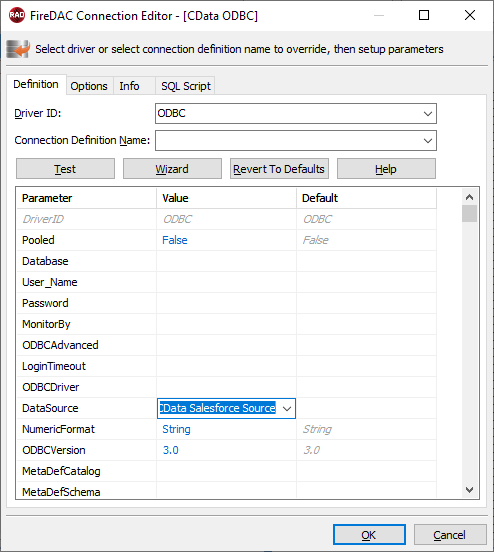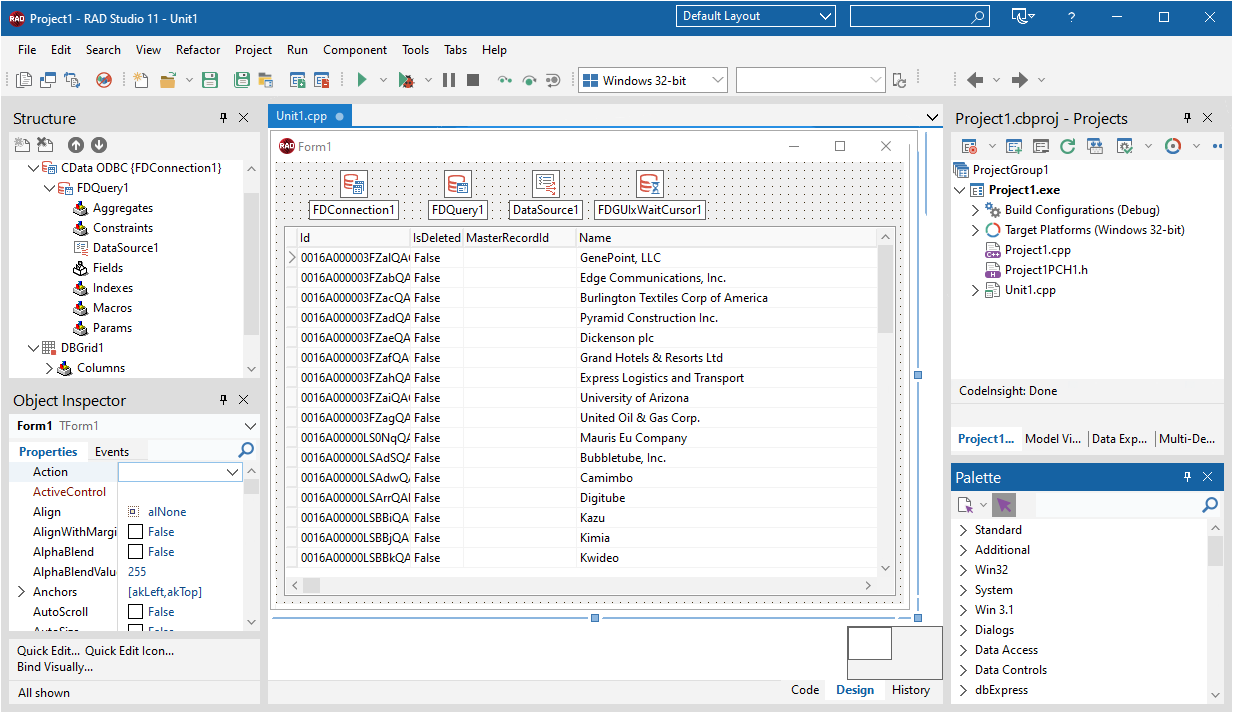各製品の資料を入手。
詳細はこちら →DataBind Controls to UM SaaS Cloud データ in C++Builder
DataBind to UM SaaS Cloud のデータ in C++Builder with standard components and controls.
最終更新日:2023-06-12The CData ODBC Driver for UM SaaS Cloud makes it easy to integrate connectivity to live UM SaaS Cloud のデータ with standard data access components in C++Builder. This article shows how to create a simple visual component library (VCL) application in C++Builder that connects to UM SaaS Cloud のデータ, executes queries, and displays the results in a grid. An additional section shows how to use FireDAC components to execute commands from code.
Create a Connection to UM SaaS Cloud データ
If you have not already, first specify connection properties in an ODBC DSN (data source name). This is the last step of the driver installation. You can use the Microsoft ODBC Data Source Administrator to create and configure ODBC DSNs.
UM SaaS Cloud 接続プロパティの取得・設定方法
デフォルトでは、本製品は本番環境に接続します。UMSaaSCloud sandbox アカウントを使用するには、UseSandbox をtrue に設定します。ユーザー / パスワード認証を使用している場合は、User にsandbox のユーザー名を設定してください。
UM SaaS Cloud への認証
UM SaaS Cloud は、Basic、OAuth、OAuthJWT(コンシューマーキー)など、複数の認証方式をサポートしています。ここではBasic 認証について説明します。認証情報の詳しい取得方法や他の認証方法については、ヘルプドキュメントの「はじめに」セクションを参照してください。
Basic 認証
Basic 認証は、セキュリティトークンとユーザー資格情報の使用に基づきます。Basic 認証を使用するには、AuthScheme をBasic に、User とPassword をログイン資格情報に設定し、SecurityToken を設定します。
デフォルトではSecurityToken が必要ですが、UM SaaS Cloud で信頼できるIP アドレスの範囲を設定することで、オプションにすることができます。
You can then follow the steps below to use the Data Explorer to create a FireDAC connection to UM SaaS Cloud.
- In a new VCL Forms application, expand the FireDAC node in the Data Explorer.
- Right-click the ODBC Data Source node in the Data Explorer.
- Click Add New Connection.
- Enter a name for the connection.
- In the FireDAC Connection Editor that appears, set the DataSource property to the name of the ODBC DSN for UM SaaS Cloud.

Create VCL Applications with Connectivity to UM SaaS Cloud データ
Follow the procedure below to start querying UM SaaS Cloud のデータ from a simple VCL application that displays the results of a query in a grid.
-
Drop a TFDConnection component onto the form and set the following properties:
- ConnectionDefName: Select the FireDAC connection to UM SaaS Cloud.
- Connected: Select True from the menu and, in the dialog that appears, enter your credentials.
-
Drop a TFDQuery component onto the form and set the properties below:
- Connection: Set this property to the TFDConnection component, if this component is not already specified.
SQL: Click the button in the SQL property and enter a query. For example:
SELECT BillingState, Name FROM Account WHERE Industry = 'Floppy Disks'- Active: Set this property to true.
Drop a TDataSource component onto the form and set the following property:
- DataSet: In the menu for this property, select the name of the TFDQuery component.
-
Drop a TDBGrid control onto the form and set the following property:
- DataSource: Select the name of the TDataSource.
- Drop a TFDGUIxWaitCursor onto the form — this is required to avoid a run-time error.

Execute Commands to UM SaaS Cloud with FireDAC Components
You can use the TFDConnection and TFQuery components to execute queries to UM SaaS Cloud のデータ. This section provides umsaascloudspecific examples of executing queries with the TFQuery component.
Connect to UM SaaS Cloud データ
To connect to the data source, set the Connected property of the TFDConnection component to true. You can set the same properties from code:
FDConnection1->ConnectionDefName = "CData UM SaaS Cloud ODBC Source";
FDConnection1->Connected = true;
To connect the TFDQuery component to UM SaaS Cloud のデータ, set the Connection property of the component. When a TFDQuery component is added at design time, its Connection property is automatically set to point to a TFDConnection on the form, as in the application above.
Create Parameterized Queries
To create a parameterized query, use the following syntax below:
FDQuery1->SQL->Text = "select * from Account where industry = :Industry";
FDQuery1->ParamByName("industry")->AsString = "Floppy Disks";
query->Open();
The example above binds a string-type input parameter by name and then opens the dataset that results.
Prepare the Statement
Preparing statements is costly in system resources and time. The connection must be active and open while a statement is prepared. By default, FireDAC prepares the query to avoid recompiling the same query over and over. To disable statement preparation, set ResourceOptions.DirectExecute to True; for example, when you need to execute a query only once.
Execute a Query
To execute a query that returns a result set, such as a select query, use the Open method. The Open method executes the query, returns the result set, and opens it. The Open method will return an error if the query does not produce a result set.
FDQuery1->SQL->Text := "select * from Account where industry = :Industry";
FDQuery1.ParamByName("industry")->AsString = "Floppy Disks";
FDQuery1->Open();
To execute a query that does not return a result set, use the ExecSQL method. The ExecSQL method will return an error if the query returns a result set. To retrieve the count of affected rows use the TFD.RowsAffected property.
FDQ.SQL.Text := "delete from Account where Id = :Id";
FDQuery1->Params->Items[0]->AsString = "x12345";
FDQuery1->ExecSQL();
AnsiString i = FDQuery1->RowsAffected;
Related Articles
Below you can find other articles for using the CData ODBC Driver with RAD Studio, Delphi, and C++ Builder.





